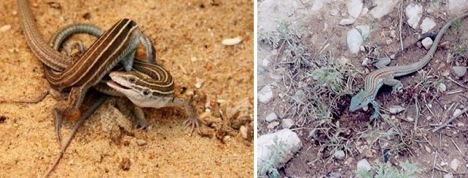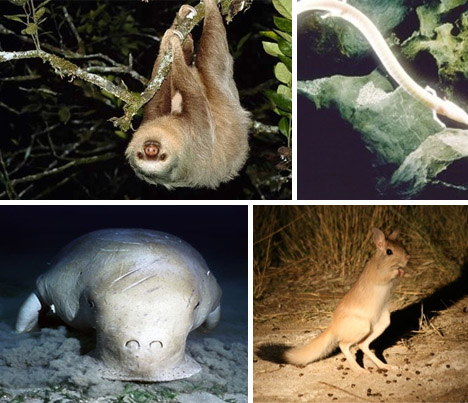
Like much of the futuristic green building designs and great green architecture of today, the ugly redheaded stepchildren of the animal kingdom don’t get much attention compared to the perennial favorite endangered animals like pandas, polar bears, and owls. These are the cute, majestic, and otherwise emblematic creatures of the endangered species list. But there are hundreds more animal species on our wondrous planet that are critically threatened and need both publicity and support. From bats the size of bees to poison-slinging mammals, lizards that don’t eat for a decade to seals with giant inflatable faces, here are the 25 strangest, most bizarre, unusual and important endangered species living on the “EDGE” (Evolutionarily Distinct & Globally Endangered) – and these aren’t even counting mind-controlling animal marvels or strange and amazing ancient animals now extinct!
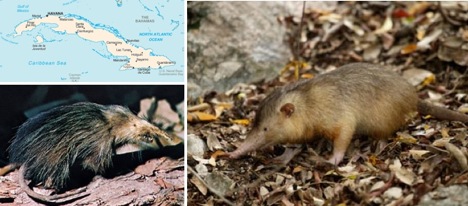
Images: top left, bottom left, right
1. Solenodon
No, it’s not an ROUS. The strange solenodon is a mammal found primarily in Cuba and Hispanola. Sure, it looks cute and manageable enough – sort of like an over-sized hedgehog. Too bad the solenodon injects rattlesnake-like venom through its teeth, the only mammal to do so. Easily annoyed, the solenodon bites at the drop of a banana leaf. Still, being both a carrion feeder and insectivore, it is a vital species in its ecosystem. It was thought to be extinct until scientists found a few still alive in 2003. It is in grave danger of extinction.

Image
2. Kakapo
This is not only the rarest, but the strangest parrot in the world. Imagine a rather portly nocturnal bird that never flies, preferring to hike through hilly forest for miles every night. It weighs in as the heaviest parrot in the world at 8 pounds. Imagine this and you have the very real (but virtually extinct) kakapo. A resident of New Zealand, which is home to a number of rare birds, there are only 62 kakapos remaining on earth. (Bonus fact: New Zealand is full of unusual creatures. It originally had no native land mammals, so its many unique birds evolved in unusual ways – which unfortunately has made them very vulnerable to mammals that were brought in during European colonization.)
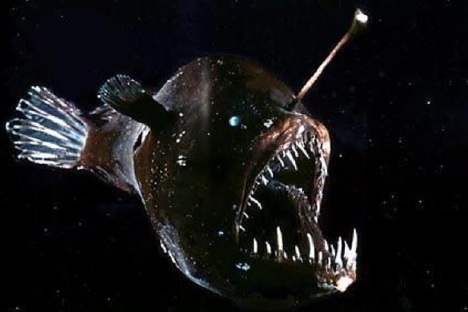
Image
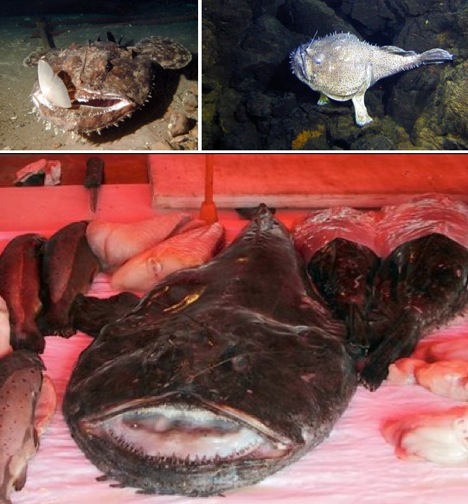
Images: left, middle, bottom
3. Angler Fish
Some guys just can’t catch a break. The male angler fish is 1/20th the size of the female angler fish. The huge, traumatizingly ugly spiny fish with the glowing “fishing rod” lure you saw in Finding Nemo? That’s the female. The male is that tiny little blob attached to his horrific goddess that you never noticed. He burrows in with his teeth and she “feeds” him ex-utero style until he eventually loses his eyeballs, then internal organs and finally his life. By then, she’s got his sperm so it doesn’t matter. Anglers are deep-sea fish, but that doesn’t mean they’re safe from threat. Go on, have another look at these lovely ladies of the deep:
Image: Tino Mauricio, Herp-Pix
4. Leaping Lesbian Lizards!
Officially named Cnemidophorus uniparens, these American desert lizards reproduce despite the fact that they’re all female. Interestingly, some of them simulate sexual acts (above, left) with each other just like male and female lizards, and it’s been discovered that when they do they reproduce more successfully than their abstemious sisters.

Image
5. The Kiwi
Everyone knows the beloved endangered kiwi is a flightless bird. As if to make up for its winged impotence, the kiwi is actually a violent, temperamental little bird. But its quirks don’t stop there. The only bird with whiskers is also distinctly dog-like in its ability to sniff out food and threats. In fact, it has the most highly developed sense of smell of any bird, lifting its “nose” (beak) into the breeze to determine its surroundings, just like a dog would. That’s probably because kiwis are also the only bird to have prominent nostrils. Contrary to popular belief, the kiwi does have wings, but they are tiny and difficult to detect under the loose, fluffy, hair-like feathers. The kiwi has many other unusual characteristics: the eggs are relatively huge, being one-fifth the bird’s weight; kiwi pairs mate for life – as long as 30 years – but tend to have feisty relationships; the females are larger and more dominant than the males. In fact, daddy kiwis incubate the young while mom hunts – for an unheard-of 80 days, no less. Did you know that kiwis are the smallest ratites on earth? Other ratites include ostrich and emu.
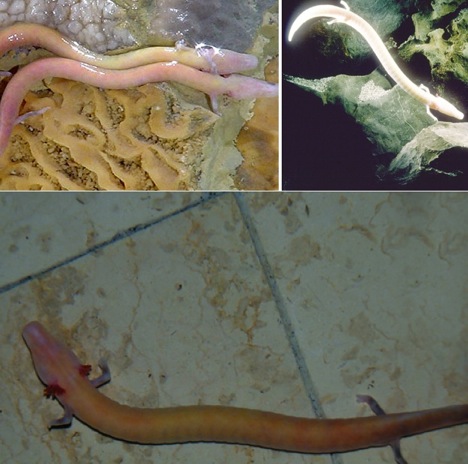
Images: 1, 2, 3
6. Olm
This unusual amphibian is blind, lives to 100, and goes ten years at a stretch without food. It lives in the subterranean waters of Italy, Croatia and Herzegovenia, where it skeeves out the locals with its strange, human-like skin. Its nickname, in fact, is the “human fish”. Unlike most amphibians, the olm lives in the water for its whole life. Another oddity of the olm: its neotenic (larval) gills.
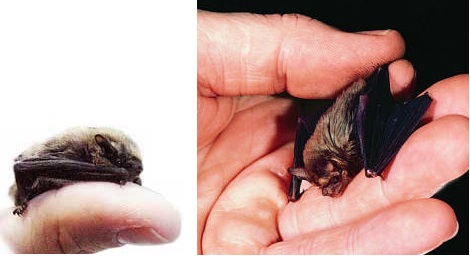
Image: 1, 2
7. Bumblebee Bat
Winning the cutest. bat. ever. award is the Bumblebee bat, which at its largest measures 1 inch. These tiny mammals hover like hummingbirds and like all bats prefer caves and love feasting on insects. They can easily perch on the tip of your thumb. This tiny bat dwells in Thailand and is considered one of the 12 most endangered species. There are fewer than 200 remaining.
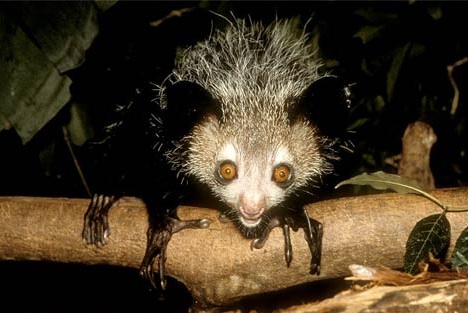
Image: Dani Jeski
8. Aye Aye
Sharing something in common with bats, aye ayes are the only primates of the mammal world to rely on echolocation for hunting. The aye aye is a rather unusual cousin of us humans. It lives in spherical nests with a small hole for entry and exit. It uses its long, slender middle finger to tap on trees in order to find tasty insects – and it uses this same finger to scoop them out. Perhaps it is due to its unusually-large eyes and ears that this unique, sensitive primate is believed to be a demon or a bad luck omen. A native of Madagascar, it is often killed at first notice by the island’s superstitious residents.
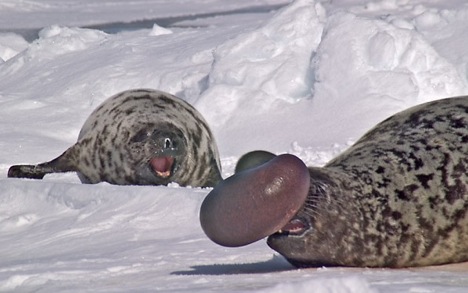
Image
9. Hooded Seal
Males of this arctic seal species have both an inflatable skull hood and nasal balloon. When aroused, angered or simply showing off, male hooded seals can inflate their sacs that are a foot or more in diameter. The nasal balloon can be inflated through one or both nostrils and is bright red. Unfortunately, due to global warming affecting the arctic environment, hooded seals are now considered by many scientists to be endangered.

Image
10. Echidna
The echidna is one of two egg-laying mammals in the world (the other is the famous duck-billed platypus). Though it looks a big hedgehog-like, this spiky creature is shy and non-confrontational. The echidna has a long, moist snout and an even longer tongue which it uses to feast on termites. It has no teeth, so it has to “chew” termites by crushing them between its tongue and mouth cavity. There are actually 4 species of echidna, and along with the platypus, they are the only monotremes. More on that in a moment.
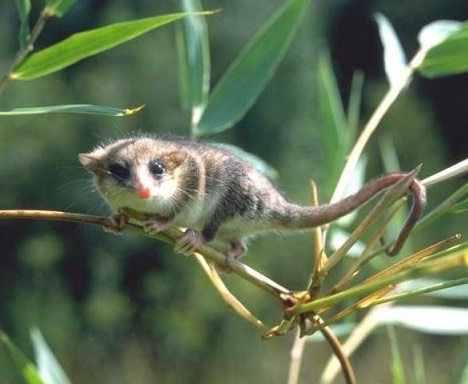
Image
11. Monito Del Monte
The “little mountain monkey” of South America is not a monkey, but rather a marsupial, thought to have arrived from Australia long ago. It’s tiny – only about 5″ full grown. They are nocturnal and carnivorous, and famous (well, among scientists) for their unusual tail, which can store enough fat to make this little pipsqueak double in size. This allows them to go for long periods without food. Sadly, the always-prepared monito del monte is in danger of extinction.
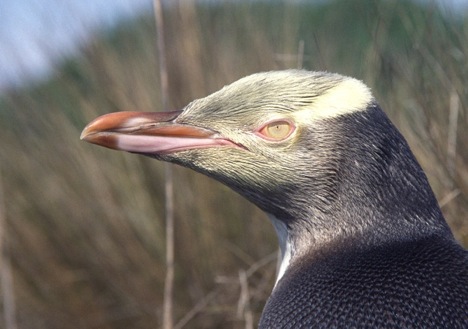
Image: D. Houston
12. The penguin with glowing yellow eyes
The yellow-eyed penguin, also native to New Zealand, is the rarest and strangest penguin in the world. It can dive to an astounding depth of 400 feet, likes to feed 20 miles from shore, and prefers to nest in the forest rather than on the beach. Penguin families tend to keep to themselves rather than congregate as most penguins do. Because of shoreline deforestation, these unusual-looking penguins are at great risk.

Image
13. Duck-Billed Platypus
It’s venomous. It’s got a duck’s bill, and otter’s feet and a mammal’s body. Oh, and it lays eggs. No wonder Western naturalists were confused by the platypus when it was first introduced. The platypus, along with the echidna, is a monotreme (egg-laying mammal). It’s native to Australia and Tasmania where it was hunted to near-extinction during the 1800s for its fur, but has been protected since the turn of the 20th century. Thought officially a protected species, the platypus is at risk because of poaching. (In future posts we will explore the varying classifications of “endangered” and some of the associated controversy and disputes.)
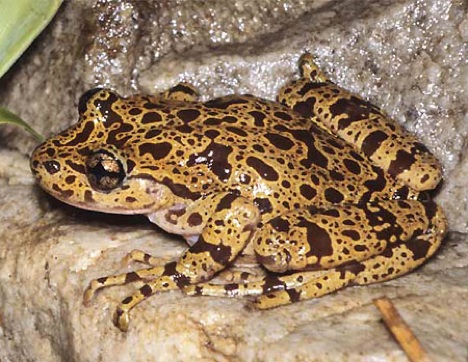
Image
14. Ghost Frog
The flat-bodied ghost frog has special adaptations to allow it to inhabit rapid streams in South Africa (as well as Skeleton Gorge, likely the reason for its spooky moniker). The young have disc-like mouths to for a suction-like grip and adults have specialized disc-like toe pads to cling to rocks in the rushing water.
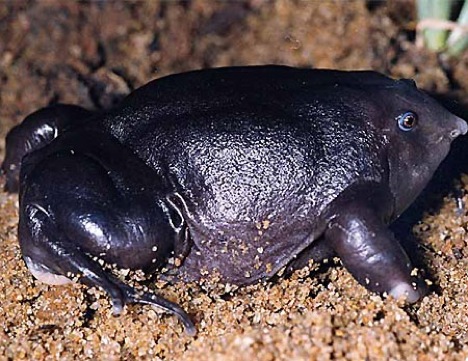
Image
15. Purple Frog
The purple frog is really purple. But its brilliant hue is not the strange thing about it. The purple frog spends much of the year living 13 feet below ground. Also called the pignose for its snubbed nose, this western Indian-dwelling frog was only discovered in 2003, in Kerala. Locals had known about the purple frog for years, but scientists were skeptical. Part of the reason purple frogs were difficult to find was simply due to the fact that they only come up for air for two weeks during monsoon season in order to mate.

Image
16. Dugong
The dugong is a cousin of the manatee and is closely related to the elephant. The dugong is unique in that it has a split (whale-like) tail and will “perch” underwater on its tail in order to keep its head above water. The dugong is thought to have inspired ancient myths about mermaids. The dugong is threatened by poachers who hunt the animal for its meat, oil, skin and bones. It is extremely endangered.
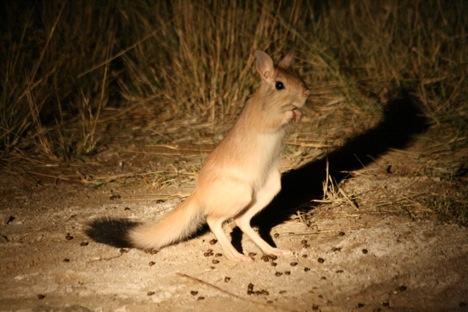
Image
17. Spring Hare
The bizarre spring hare had taxonomists scratching their heads for years. It’s been classified with jerboas (jumping rodents), squirrels and even porcupines. It’s now classified on its own, and it resembles both a kangaroo and hare. It has specialized short limbs with claws for digging as well as flexible ear flaps that can be used to seal off the ear canal to protect against the elements and debris. It’s also got a funny resting position that looks a lot like the yoga Dolphin post: it stretches its long hind legs forward and then rests its head and arms directly on the ground
18. Sumatran Rabbit
That’s not really its name; it doesn’t have one. Meet the rarest rabbit in the world, which has only been seen twice in the last century at least. Locals didn’t even know it existed. The “Sumatran rabbit” is thought to be nearly extinct. (Note: there are very few available images of this incredibly rare animal, and most are grainy at best – click here to view.)

Image
19. Sloth
The sloth belongs to the edentate family, which also includes anteaters, armadillos, and echidnas. Most edentates are either threatened or endangered species. There are a number of unusual facts about the sloth. All sloths have three toes, but “two-toed” sloths only have 2 claws. Sloths often hunt in packs. They can actually move quickly and will slash with their large claws – the slow-moving behavior is to avoid predators like hawks. They actually hang most of their lives. Sloths typically have over 600 species of bacteria, plants and animals living on them at any given time, and will often feed on themselves when they are hungry. (Algae is the main snack.) Famously, these unusual creatures can rotate their heads 270 degrees. Lore has it that sloths adore beer and are able to “hold their liquor” amazingly well.

20. Choose
There are so many endangered and threatened animal species in the world it is hard to just pick twenty. So, go ahead and read through lists of more and decide for yourself what the strangest is then drop back by and leave a comment with your thoughts. Who knows, maybe the semi-aquatic hairless ape should make the list.
Sources:



